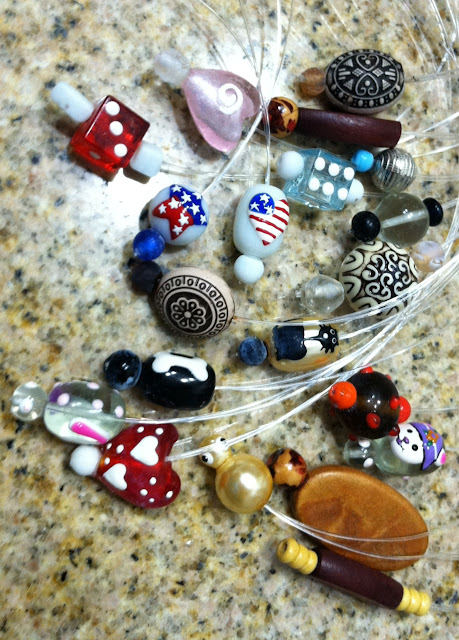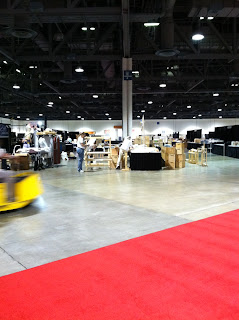First I have to say a few words about the conference in general. I have to acknowledge that it is hard work to organize a conference. Been there, done that. And it's expensive to rent space, buy supplies, pay staff, etc. But this year it seemed a bit pricey and disjointed.
Classes were held in three different locations. Not a good start. Instead of one large location where people gathered between events, we were spread all over. The food services in the conference center were ridiculous. $4 for a bottle of soda? Seriously? Not the HGA's fault, but this type of thing should be considered when choosing a location.
 The vendor hall was a slight disappointment. Not the vendors' fault. But times are changing and since it's so easy to purchase anything you need over the internet, anything you buy at a conference has to be rare enough or enough of a bargain that you're willing to cart it home. I think with so many people having to tighten their belts, there were fewer shoppers than could support such a large marketplace. I would hate to see the vendor hall end, but it does need to evolve. Since I was driving and getting purchases home wasn't a big issue, I did buy a couple of pounds of reasonably priced roving and some Firestar to use for blended batts. And some socks with sheep. Every weaver and spinner should have socks with sheep, right?
The vendor hall was a slight disappointment. Not the vendors' fault. But times are changing and since it's so easy to purchase anything you need over the internet, anything you buy at a conference has to be rare enough or enough of a bargain that you're willing to cart it home. I think with so many people having to tighten their belts, there were fewer shoppers than could support such a large marketplace. I would hate to see the vendor hall end, but it does need to evolve. Since I was driving and getting purchases home wasn't a big issue, I did buy a couple of pounds of reasonably priced roving and some Firestar to use for blended batts. And some socks with sheep. Every weaver and spinner should have socks with sheep, right?Final gripe before I get down off my soapbox: the fashion show. After the Albuquerque show two years ago, I had really high expectations for this year's show. What a disappointment. The lighting was bad, the slides crediting the artists were out of synch, and the staging... Oh, my. I applaud the organizers for using models of all shapes and sizes. It's refreshing to see real clothing on real women. But there is simply no place in a fashion show for visible panty lines. Most of the models were in black leggings that were far too small (plus one memorable spandex or perhaps wetsuit fabric garment). Would it have been that hard to provide the models with slacks and tanks that fit well? I know there is a trend toward tight clothing, but please, let's showcase the artists' garments - not the hindquarters of the models. I have to say that if my weaving was of a caliber to be featured in a show, I would think twice before trusting the Convergence people to stage my work.
Down off soapbox. Nonetheless, I had a wonderful time at Convergence. Met a lot of new people and had a chance to spend time with friends. And two of three classes were fabulous.
I took a two-day workshop called Machine Knitting to Dye For, taught by Nancy Roberts. There were only five students in the class, so we got a lot of individual instruction and whenever someone had a potential disaster (which happens a lot with beginning machine knitters), Nancy was right there to rescue us. The basic concept is that you use a knitting machine to make blanks in the basic shape and size of the finished garment you want to make. Then you dye the fabric, unravel it, and knit it by hand or machine into your final garment. Theoretically, you get more control over the placement of color. And you can get longer repeats of color than you would when space-dyeing yarn.
Nancy brought a lot of sample of her work.
Then we got down to work with the machines. After just a few minutes of instruction we were making blanks for sampling. Even with blunders, it was so much fun and so fast knitting with the machine that I had made up my mind before we broke for lunch to buy the machine I was working on. This is a Silver Reed LK150, an entry-level machine that does basic stockinette knitting. It also has optional carriages for Fair Isle and Intarsia knitting, which, of course, came home with me. Like I need any more hobbies. But I have wanted to use a knitting machine ever since Mom had one in the sixties (which, incidentally, never worked), This will give me a chance to use up some of the yarn in my stash that I would never weave with. Give me a few more minutes and I will come up with yet more rationalizations for having bought another gadget.
 On day two of class, we started working with dyes. Nancy presented a simple method of calculating the amount of liquid and proportion of different dye colors for a given piece of fabric by weight, and we made these samples. The blue on the right here was supposed to be a lesson in controlling the intensity of a single color. I had a little issue actually getting the whole stripe colored, but lesson learned. The others were methods of transitioning between two separate colors (browns on the left) and three separate colors (reds and purples on the right). By the time we got to the three color sample I was getting a handle on painting the stripes.
On day two of class, we started working with dyes. Nancy presented a simple method of calculating the amount of liquid and proportion of different dye colors for a given piece of fabric by weight, and we made these samples. The blue on the right here was supposed to be a lesson in controlling the intensity of a single color. I had a little issue actually getting the whole stripe colored, but lesson learned. The others were methods of transitioning between two separate colors (browns on the left) and three separate colors (reds and purples on the right). By the time we got to the three color sample I was getting a handle on painting the stripes.Finally, we had to choose our own color combinations and paint our blanks. I started with the blue and green piece on the left below. Was supposed to be purple transitioning to teal but I didn't like the first set of colors I made and by the time I finished fiddling with them, there was not so much purple. I took a lot of time painting the stripes. Even though the colors naturally bleed from one section to another, for some reason they don't like to seep into the dividing rows, which are simply knit with a looser tension. So there is quite a bit of undyed or very lightly dyed yarn in my fabric, which I actually like. By the time I got to the second blank, we were running out of time, so I very quickly made up four colors by blending different proportions of red with yellow and slopped the dye on my blank. And I loved the result. Next step will be to unravel the blanks and then knit them into the bag. That's going to be a while.
Mid-conference I had to move to a different hotel. That was fun. Had to move out of the Travelodge in the morning and couldn't check in at the Marriott until late that afternoon. Thanks to Gail and Kathleen for sheltering Big Tom in their room so I didn't have to leave him unattended in my car all day. (For those who don't already know about Tom, he's my drum carder.)
My second class was in adding electric components to "wearable" art. Basically, we stitched circuits between a battery holder and some LED lights using silver-coated thread. When the battery is inserted into the holder, the LEDs light up. I tried to use a resistor and a light sensor in my project, but they did not allow enough current through to light all three LCDs so I settled for an always-on design where you have to remove the battery to turn off the circuit. The idea has potential but I wish we had learned more about the different components and basic formulas for figuring out how much load to put on a battery and using resistors properly.
 |
| The Clutch Without Battery |
 |
| Battery Inserted |
My last class was Weaving on a Bow Loom, taught by Marilyn Romatka . This technique is featured in her book, Creative Crafts of the World. This is done in Thailand but has been found in earlier aboriginal cultures as well. Marilyn was an entertaining and engaging teacher, and I would take another class from her in a heartbeat. This is a very simple technique that could be taught to children, and the equipment and supplies can be extremely reasonable. For the loom, a dowel, two paper clips, a piece of fairly sturdy foam, and some electrical tape are all that's required. For the warp - whatever string or thread you choose, beads if desired, and two more paper clips to hook it to the bow. And for the weft, again, whatever string or thread. You are limited to a fairly narrow band of fabric, but the sky's the limit when it comes to colors and bead placement. The bottom photo here shows of the "bridge" made of foam, that holds the unused beads out of the way and keeps the warp threads in order.
After class, I made one final round of the vendor hall, visited with a couple of friends, and made my way home. Sat down in my chair with Tallulah and took a three-hour nap. Woke up long enough to take a shower and another nap till bedtime. Went to bed, slept till six, got up, and took another nap. All told, I think I pretty much slept for 24 hours and was still tired. Good thing I don't have this much fun all the time!
 Added 3/5/13: I gave myself Marilyn's book for Christmas and have been thoroughly enjoying it.
Added 3/5/13: I gave myself Marilyn's book for Christmas and have been thoroughly enjoying it. 


































